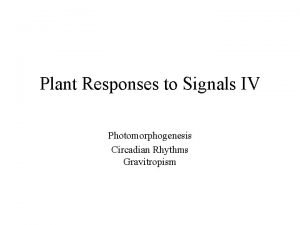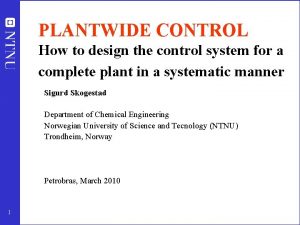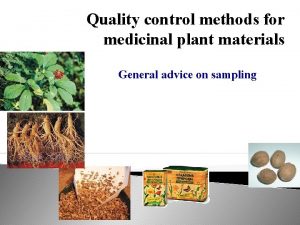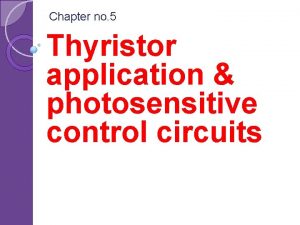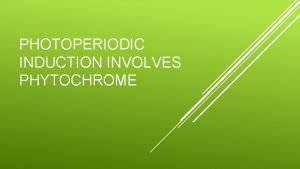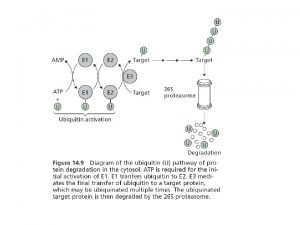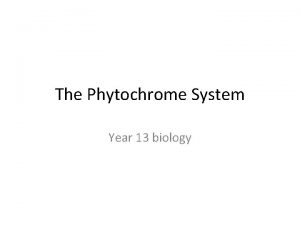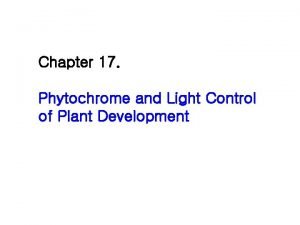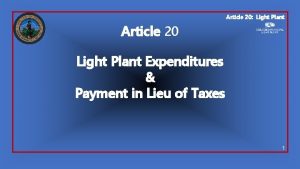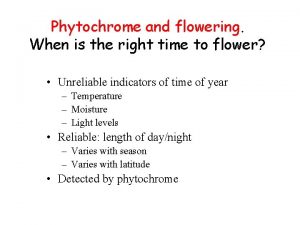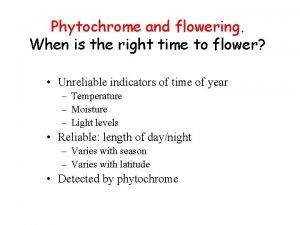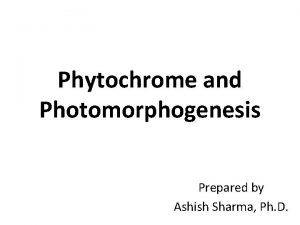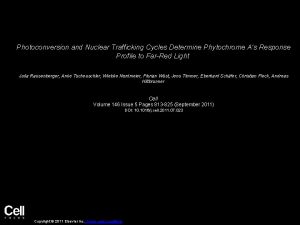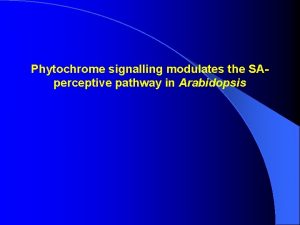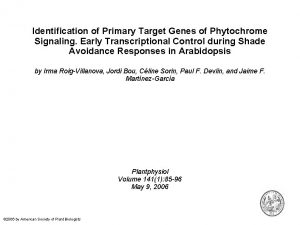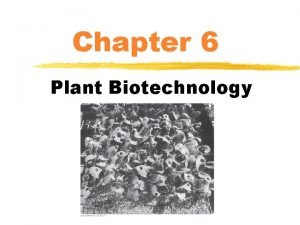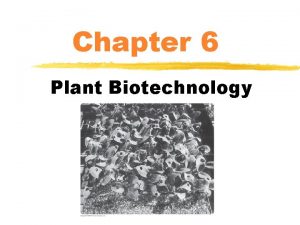Chapter 17 Phytochrome and Light Control of Plant




















- Slides: 20

Chapter 17. Phytochrome and Light Control of Plant Development

Corn and bean seedlings grown in the light or the dark De-etiolated Light-grown corn etiolated Dark-grown corn De-etiolated Light-grown bean etiolated Dark-grown bean Developmental changes by light (photomorphogenesis) (transformation from the etiolated to the green state) 1. A decrease in the rate of stem elongation 2. The beginning of apical-hook straightening 3. The initiation of the synthesis of pigments

development Function of light photosynthesis stomata opening flowering Phototropin: blue light photoreceptor Cryptochrome: blue light Phytochrome: red light

The photochemical and biochemical properties of phytochrome

Typical photoreversible responses induced by phytochrome in variety of higher and lower plants


Lettuce seed germination is a typical photoreversible response controlled by phytochrome Red, 650 -680 nm Far-red, 710 -740 nm dark

Phytochrome can interconvert between Pr and Pfr forms Pr : red – light absorbing form Pfr: far- red - light absorbing form

Absortion spectra of purified oat phytochrome in the Pr and Pfr forms overlap Red light Pr : 15% Pfr : 85% Far-red light Pr : 97% Pfr : 3%

Pfr is the physiologically active forms of Phytochrome - Wild type: short hypocotyl by white light - hy mutant (phytochrome mutant): long hypocotyl by white light If the phytochrome-induced response to white light is caused by the absence of Pr, such phytochrome-mutants should have short hypocotyl in both darkness and white light. Instead, the opposite occurs.

De-etiolated Pr of Pfr form? etiolated

Phytochrome is a dimer composed of two polypeptides Native phytochrome is a soluble protein with MW about 250 k. Da. It occurs as a dimer made up of two equivalent subunits. Each subunit consists of two components: light absorbing pigment: chromophore a polypeptide chain: apoprotein (125 KDa)

Structure of the Pr and Pfr forms of the chromophore

Structure of the phytochrome dimer

Phytochromobilin is synthesized in plastids 1. Synthesized in plastids 2. Transported into cytosol by a passive process 3. Assembly of the phytochrome apoprotein (autocatalytic) 4. Consists of holoprotein hy 1 and hy 2 mutant: fail to supress hypocotyl elongation. chromophore biosynthesis mutant, normal apoprotein.

Both chromphore and protein undergo conformational changes Absorption of light The Pr chromophore undergoes cis-trans isomerization The protein moiety of phytochrome holoprotein also undergoes a subtle conformational change ( both N-terminal and C-terminal regions)

Two types of phytochromes have been identified Type Ⅰ Type Ⅱ Dark 9 : 1 Light 5 : 5 Existence Etiolated plant Green plant and seed

Phytochrome is encoded by a multigene family 5 structurally related phytochrome genes in Arabidopsis (PHYA, PHYB, PHYC, PHYD, PHYE)

PHY genes encode two types of phytochrome Phytochrome gene family (PHY) PHYA Type I PHYB PHYC PHYD Type II PHYE

PHYA m. RNA red Pr far-red Pfr ubiquitin + Response ATP ubiquitin degradation PHYB PHYC PHYD PHYE m. RNA Pr red far-red Pfr Response
 Phytochrome function
Phytochrome function Light light light chapter 23
Light light light chapter 23 Light light light chapter 22
Light light light chapter 22 Chapter 22
Chapter 22 Tronsmo plant pathology and plant diseases download
Tronsmo plant pathology and plant diseases download Tronsmo plant pathology and plant diseases download
Tronsmo plant pathology and plant diseases download Tronsmo plant pathology and plant diseases download
Tronsmo plant pathology and plant diseases download Put out the light
Put out the light Difference between light dependent and light independent
Difference between light dependent and light independent The bouncing off of light.
The bouncing off of light. Objective of plant breeding
Objective of plant breeding Plant breeding for disease resistance
Plant breeding for disease resistance Plant introduction in plant breeding
Plant introduction in plant breeding Materials block light
Materials block light Plant wide control
Plant wide control Quality control methods for medicinal plant materials
Quality control methods for medicinal plant materials Distinguish between process control and product control
Distinguish between process control and product control Negative vs positive control operon
Negative vs positive control operon Error control and flow control
Error control and flow control Emergency light system control using scr
Emergency light system control using scr Basic purposes of communication
Basic purposes of communication
